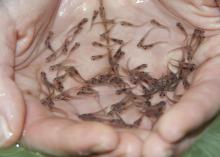Information Possibly Outdated
The information presented on this page was originally released on July 8, 2016. It may not be outdated, but please search our site for more current information. If you plan to quote or reference this information in a publication, please check with the Extension specialist or author before proceeding.
Catfish production holds steady as demand stays high
STONEVILLE, Miss. -- As demand for catfish remains high, the only components of its production trending down this year in Mississippi are pond acreage and the price of feed.
Producers are receiving an average of $1.12 to $1.21 per pound of catfish and paying less than $380 for a ton of feed. To Jimmy Avery, Extension aquaculture professor at the Mississippi State University Delta Research and Extension Center in Stoneville, those data are good news for the bottom line.
“Based on feed purchases and processing data, I’m anticipating we should reach the same level of production as last year,” Avery said. “We have had a hatchery season that was stop-again, start-again at times, but it ended up being fairly strong. Most of our hatcheries have met their goals, and the difference between a good and bad season is meeting goals as quickly as possible before labor and equipment expenses cut into profit margins.”
Producers were paying almost $500 a ton for feed in 2013 and 2014, he said, but prices fell last year to the $350 to $380 range. Those numbers have held this year.
Pond acreage this year is a projected 36,000 acres, which continues a moderate downward trend. Producers raised catfish in 41,000 acres of water in 2015.
“Those farmers looking to take advantage of higher fish prices are looking to new production systems such as split-ponds, highly aerated small ponds, or switching to hybrid catfish,” Avery said. “These new technologies allow the farmer to produce more pounds off the space they have.
“A large percentage of the ponds taken out of production were repurposed to other crops that had a higher commodity price,” Avery said. “There are a few ponds being switched from row crops back to fish production, but that is the exception rather than the rule.”
As growers begin to renovate older ponds, many are switching to split-pond systems, which employ paddlewheels to aerate ponds and allow producers more management of oxygen levels.
“In your typical 10-acre pond, fish are only stocked on about two of the acres in a split-cell design,” said Mark Peterman, MSU Extension Service aquaculture associate. “The rest is used for nutrient recycling, oxygen production and water exchange. The paddlewheels circulate water and oxygen through the fish cell and provide for a more stress-free environment.”
High demand for fingerlings to stock ponds is also keeping supply tight.
“There were probably a few catfish farmers who were not able to stock their ponds as much as they would have liked,” Peterman said. “Fingerlings are usually hard to come by.”
The catfish industry made national news this summer when the U.S. Senate voted to shut down the country’s only catfish inspection program, which the U.S. Department of Agriculture’s Food Safety and Inspection Service took over from the U.S. Food and Drug Administration earlier this year. The U.S. House has not yet taken up the resolution.
Avery said he believes switching regulatory oversight back to the FDA would compromise food safety and put consumers at risk. An anticipated resurgence in foreign fish imports would hurt domestic producers, including those in the top catfish-producing state.
“U.S. farm-raised catfish growers are fortunate to have a very clean record with no recalls on their products,” Avery said. “Under FDA inspection, exporting countries routinely had 15 to 18 shipments per year that were seized and rejected because they had veterinary drug residues or cancer-causing compounds in them. With the switch, the FSIS has rejected about 33 percent of shipments received from major exporters. FSIS inspection is a win for U.S. consumers because it ensures they are getting healthy, safe catfish.”
Avery added that the only ongoing disease problem seen in Mississippi’s catfish industry is not a threat to humans.
“Trematode parasites are transferred to fish by pelicans, and our diagnostic lab has been seeing an increase in cases this year,” Avery said. “In these cases, we have seen that the disease stunts the growth of infected fish. In no way does this pose a threat to humans because the parasite resides in the skin, which is removed when the fish is processed.”




